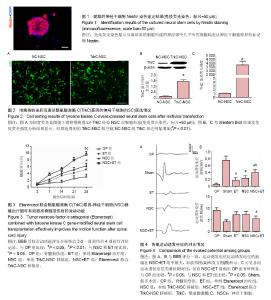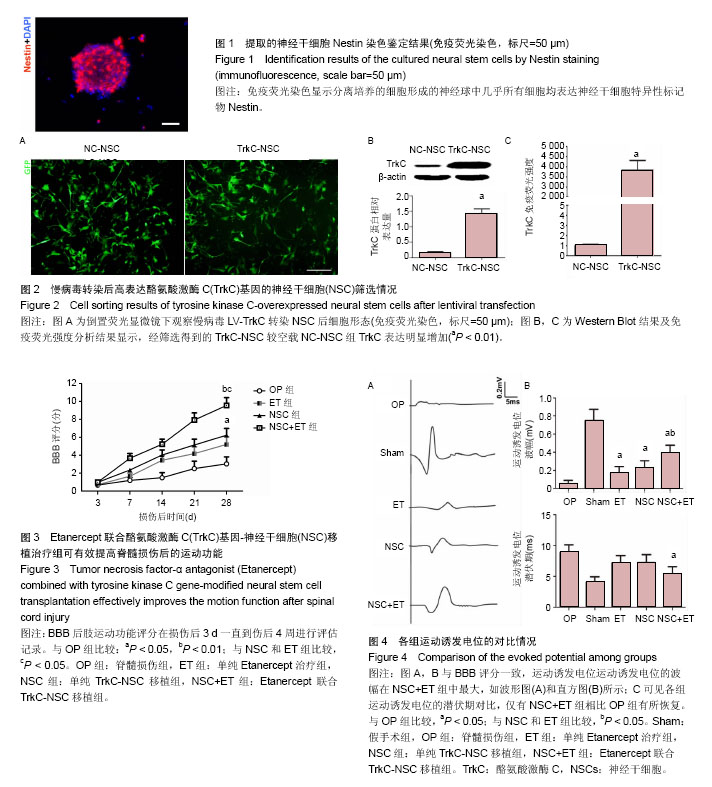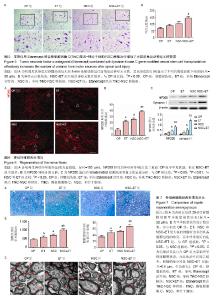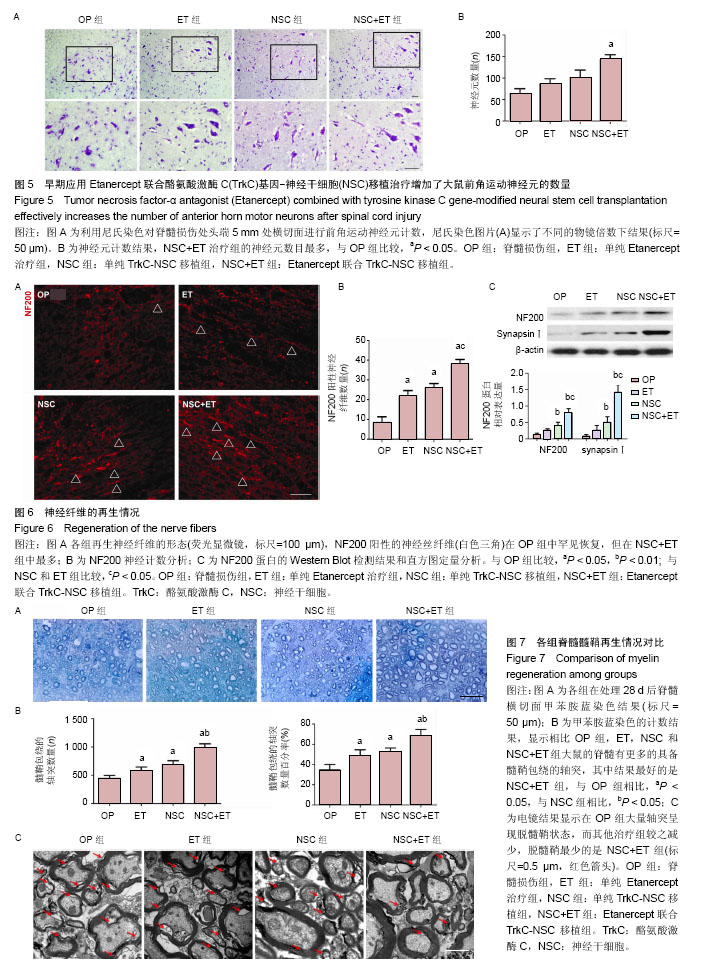Chinese Journal of Tissue Engineering Research ›› 2017, Vol. 21 ›› Issue (21): 3338-3345.doi: 10.3969/j.issn.2095-4344.2017.21.010
Previous Articles Next Articles
Tumor necrosis factor-alpha antagonist combined with tyrosine kinase C gene- modified neural stem cell transplantation for spinal cord injury
Wang Le1, 2, Chen Ning-ning1, 2, Li Ting-ting3, Zhao Xiao-yang1, 2, Wei Fu-xin1, 2, Cui Shang-bin1, 2, Wan Yong1, 2, Liu Shao-yu1, 2
- 1Department of Spine Surgery, the First Affiliated Hospital, Sun Yat-sen University, Guangzhou 510080, Guangdong Province, China; 2Guangdong Provincial Key Laboratory of Orthopedics and Traumatology, Guangzhou 510080, Guangdong Province, China; 3Department of Rehabilitation, the Eastern Hospital of the First Affiliated Hospital, Sun Yat-sen University, Guangzhou 510700, Guangdong Province, China
-
Revised:2017-06-08Online:2017-07-28Published:2017-08-02 -
Contact:Liu Shao-yu, Professor, Chief physician, Doctoral supervisor, Department of Spine Surgery, the First Affiliated Hospital, Sun Yat-sen University, Guangzhou 510080, Guangdong Province, China; Guangdong Provincial Key Laboratory of Orthopedics and Traumatology, Guangzhou 510080, Guangdong Province, China -
About author:Wang Le, M.D., Physician, Department of Spine Surgery, the First Affiliated Hospital, Sun Yat-sen University, Guangzhou 510080, Guangdong Province, China; Guangdong Provincial Key Laboratory of Orthopedics and Traumatology, Guangzhou 510080, Guangdong Province, China -
Supported by:the General Project of National Natural Science Foundation of China, No. 81272007; the Natural Science Foundation of Guangdong Province, No. 2016A030313213
CLC Number:
Cite this article
Wang Le, Chen Ning-ning, Li Ting-ting, Zhao Xiao-yang, Wei Fu-xin, Cui Shang-bin, Wan Yong,Liu Shao-yu. Tumor necrosis factor-alpha antagonist combined with tyrosine kinase C gene- modified neural stem cell transplantation for spinal cord injury[J]. Chinese Journal of Tissue Engineering Research, 2017, 21(21): 3338-3345.
share this article

2.1 慢病毒LV/TrkC转染神经干细胞后筛选结果 原代提取的神经干细胞在培养24 h后,50%-75%的细胞呈贴壁状态,48 h后出现细胞集落生长,并开始悬浮;72 h后细胞逐渐悬浮并细胞增殖速度增加;约4 d出现小的神经球(neurosphere),待生长六七天时,小神经球生长至150- 200 μm则可进行传代。传至2代时,细胞形态基本均一,增殖旺盛,折光性好,Nestin染色阳性比例高(图1)。 将细胞种植到24-well中培养,测试不同滴度LV-GFP感染神经干细胞后绿色荧光强度。发现MOI值=10时,镜下所见的神经球绿色荧光表达最为强烈,细胞质和细胞核内均有GFP-TrkC表达。培养到第7天仍有强GFP绿色荧光表达。通过转染成功后加入嘌呤霉素,筛选出了高表达TrkC基因的神经干细胞(图2)。 2.2 大鼠后肢运动功能变化 实验用BBB评分对各组大鼠的后肢运动功能情况进行评估,尽管OP组的运动恢复十分有限,单纯ET组的BBB评分在损伤2周后开始较OP组有明显的恢复而且这种恢复逐渐明显一直到末次观察(损伤后4周)(P < 0.05)(图3),这表明肿瘤坏死因子α在脊髓横断损伤模型的继发性损伤中也扮演重要角色。 另外从损伤后2周开始,NSC+ET组相比OP组明显促进了大鼠运动功能恢复(P < 0.05),这种恢复在3周和4周更为明显(P < 0.01);而联合治疗在4周后功能恢复好于两个单纯治疗组(P < 0.05)。在NSC+ET组,损伤后4周10只大鼠里有3只可以做到负重步行(BBB评分10分),结果表明Etanercept早期应用可以有利于脊髓运动功能恢复,联合TrkC-NSC治疗恢复更好。 2.3 大鼠运动诱发电位变化 测量各组大鼠的运动诱发电位(MEP),运动诱发电位作为临床常用的脊髓检测制备,主要用于评估运动神经系统。通过运动诱发电位的波幅和潜伏期可初步估计出脊髓内兴奋的轴突数目和神经的信号传导能力。 运动诱发电位的信号在OP组非常差,ET组,NSC组和NSC+ET组的运动诱发电位波幅较OP组明显升高,各组运动诱发电位波幅最大的是NSC+ET组(P < 0.05)。但相比假手术组仍有较大差距。这些结果表明早期应用Etanercept联合TrkC-NSC移植可促进神经再生;另外,Etanercept的抗炎和抗凋亡作用促进了神经细胞存活以及运动神经功能恢复。相比BBB评分,运动诱发电位的波幅在ET组和NSC组是差异无显著性意义(P > 0.05)。运动诱发电位仅在NSC+ET组的潜伏期较OP组缩短,差异有显著性意义(P < 0.05;图4)。 2.4 大鼠脊髓前角神经元计数变化 实验利用尼氏染色来评估脊髓损伤后早期应用Etanercept联合TrkC-NSC移植对脊髓前角运动神经元的数目的影响,计数位置为损伤处尾端。统计可知NSC组,ET组和NSC+ET组的前角运动神经元个数相比OP组都有显著增加(P < 0.05),NSC+ET组的前角运动神经元个数相比其他组均有增加(P < 0.05),说明脊髓损伤后早期应用Etanercept联合TrkC-NSC移植28 d后相比单纯TrkC-NSC移植或单纯Etanercept治疗可得到更多存活的前角运动神经元。因评估的位置是脊髓损伤横断处的尾端,故存活神经元可能与ET对损伤后残存神经元的保护,或移植后神经干细胞迁移分化有关(图5)。 2.5 大鼠脊髓神经元相关标记物情况 为评估脊髓损伤后早期应用Etanercept联合TrkC-NSC移植治疗的神经再生情况,以及Etanercept的抗炎抗凋亡作用影响下NSC+ET组相比NSC或ET组的恢复情况,实验利用几种神经元再生的相关标记物。NF200的表达在ET,NSC组和NSC+ET组相比OP组均有升高(P < 0.05),而NF200表达最高的是NSC+ET联合治疗组(P < 0.05)。与突触功能密切相关的蛋白synapsin Ⅰ,在ET,NSC组和NSC+ET组相比OP组均有升高(P < 0.05),表达最高的是NSC+ET联合治疗组(P < 0.05)。另外结果还显示,NSC组的NF200及synapsinⅠ表达要高于ET组(P < 0.05)(图6)。 实验还利用免疫荧光检测NF200在脊髓损伤处的生成情况,为评估各组轴突再生的程度。ET组,NSC组和NSC+ET组在损伤后4周的神经丝数目相比对照组均明显增加(P < 0.05)。在NSC组中NF200阳性的神经丝数目要高于ET组(P < 0.05),NSC+ET组的神经丝数目最多(P < 0.05),表明联合治疗效果优于单独ET或TrkC-NSC移植,这其中的效果大部分归功于早期应用Etanercept对肿瘤坏死因子α的拮抗作用(图6)。 2.6 大鼠脊髓损伤区域的髓鞘再生 为检测脊髓损伤后早期应用Etanercept联合TrkC-NSC移植治疗能否促进脊髓髓鞘再生,实验使用甲苯胺蓝轴突染色后光镜计数。结果显示,OP组的脱髓鞘情况非常严重,而在ET组,NSC组和NSC+ET组中实验发现有更多的具有髓鞘包绕的轴突(P < 0.05)。而NSC组中轴突被髓鞘包绕的个数和比例都高于ET组,差异有显著性意义(P < 0.05)。NSC+ET组得到的具备髓鞘包绕的轴突数量和比率均高于其他组(P < 0.05)。电镜观察可见到脱髓鞘情况和甲苯胺蓝染色计数结果一致,在对照组中实验可见包绕轴突的髓鞘的薄层分离,髓鞘结构疏松(图7)。"

| [1] Spinal cord injury facts and figures at a glance. J Spinal Cord Med. 2013;36(6):715-716.[2] Ducker TB, Spengler DM, Balderston R, et al. Spinal cord injury and glucocortical steroid therapy: good news and bad. J Spinal Disord. 1990;3(4):433. [3] Donnelly DJ, Popovich PG. Inflammation and its role in neuroprotection, axonal regeneration and functional recovery after spinal cord injury. Exp Neurol. 2008;209(2): 378-388.[4] Bramlett HM, Dietrich WD. Progressive damage after brain and spinal cord injury: pathomechanisms and treatment strategies. Prog Brain Res. 2007;161:125-141. [5] Benucci M, Li G F, Meacci F, et al. Antidrug antibodies against TNF-blocking agents: correlations between disease activity, hypersensitivity reactions, and different classes of immunoglobulins. Biologics. 2015;9:7-12. [6] Nockels R, Young W. Pharmacologic strategies in the treatment of experimental spinal cord injury. J Neurotrauma. 1992;9 Suppl 1:S211-S217.[7] Yune TY, Chang MJ, Kim SJ, et al. Increased production of tumor necrosis factor-alpha induces apoptosis after traumatic spinal cord injury in rats. J Neurotrauma. 2003; 20(2):207-219. [8] Wang CX, Nuttin B, Heremans H, et al. Production of tumor necrosis factor in spinal cord following traumatic injury in rats. J Neuroimmunol. 1996;69(1-2):151-156. [9] Chen K B, Uchida K, Nakajima H, et al. Tumor necrosis factor-alpha antagonist reduces apoptosis of neurons and oligodendroglia in rat spinal cord injury. Spine (Phila Pa 1976). 2011;36(17):1350-1358. [10] Lebedev SV, Karasev AV, Chekhonin VP, et al. Study of the efficiency of transplantation of human neural stem cells to rats with spinal trauma: the use of functional load tests and BBB test. Bull Exp Biol Med. 2010;149(3):377-382.[11] Sobani ZA, Quadri SA, Enam SA. Stem cells for spinal cord regeneration: current status. Surg Neurol Int. 2010;1:93.[12] Kan EM, Ling EA, Lu J. Stem cell therapy for spinal cord injury. Curr Med Chem. 2010;17(36):4492-4510.[13] Takahashi Y, Tsuji O, Kumagai G, et al. Comparative study of methods for administering neural stem/progenitor cells to treat spinal cord injury in mice. Cell Transplant. 2011;20(5):727-739.[14] Sakaguchi M, Okano H. Neural stem cells, adult neurogenesis, and galectin-1: from bench to bedside. Dev Neurobiol. 2012;72(7):1059-1067.[15] Ekshyyan O. Apoptosis in acute and chronic neurological disorders. Front Biosci. 2004;9:1567.[16] Wang JM, Zeng YS, Wu JL, et al. Cograft of neural stem cells and schwann cells overexpressing TrkC and neurotrophin-3 respectively after rat spinal cord transection. Biomaterials. 2011,32(30):7454-7468.[17] Basso DM, Beattie MS, Bresnahan JC. Graded histological and locomotor outcomes after spinal cord contusion using the NYU weight-drop device versus transection. Exp Neurol. 1996;139(2):244-256.[18] Wang L, Wei FX, Cen JS, et al. Early administration of tumor necrosis factor-alpha antagonist promotes survival of transplanted neural stem cells and axon myelination after spinal cord injury in rats. Brain Res. 2014;1575:87-100.[19] Cen J, Wu H, Wang J, et al. Local injection of lentivirus encoding LINGO-1-shRNA promotes functional recovery in rats with complete spinal cord transection. Spine (Phila Pa 1976). 2013;38(19):1632-1639.[20] Guo J, Zeng Y, Li H, et al. Cotransplant of neural stem cells and NT-3 gene modified Schwann cells promote the recovery of transected spinal cord injury. Spinal Cord. 2007;45(1): 15-24.[21] Ferguson AR, Christensen RN, Gensel JC, et al. Cell death after spinal cord injury is exacerbated by rapid TNF alpha-induced trafficking of GluR2-lacking AMPARs to the plasma membrane. J Neurosci. 2008;28(44):11391-11400.[22] Beattie MS, Hermann GE, Rogers RC, et al. Cell death in models of spinal cord injury. Prog Brain Res. 2002;137:37-47.[23] Novikova LN, Novikov LN, Kellerth JO. Differential effects of neurotrophins on neuronal survival and axonal regeneration after spinal cord injury in adult rats. J Comp Neurol. 2002; 452(3):255-263.[24] Wang JM, Zeng YS, Liu RY, et al. Recombinant adenovirus vector-mediated functional expression of neurotropin-3 receptor (TrkC) in neural stem cells. Exp Neurol. 2007; 203(1):123-127.[25] Xiong Y, Zhu JX, Fang ZY, et al. Coseeded Schwann cells myelinate neurites from differentiated neural stem cells in neurotrophin-3-loaded PLGA carriers. Int J Nanomedi. 2012;7: 1977-1989.[26] Mohler KM, Torrance DS, Smith CA, et al. Soluble tumor necrosis factor (TNF) receptors are effective therapeutic agents in lethal endotoxemia and function simultaneously as both TNF carriers and TNF antagonists. J Immunol. 1993; 151(3):1548-1561.[27] Spencer-Green G. Etanercept (Enbrel): update on therapeutic use. Ann Rheum Dis. 2000;59 Suppl 1:i46-i49.[28] Roozbehi A, Joghataie MT, Mehdizadeh M, et al. The effects of cyclosporin-A on functional outcome and axonal regrowth following spinal cord injury in adult rats. Acta Med Iran. 2012; 50(4):226-232.[29] Sevc J, Goldberg D, van Gorp S, et al. Effective long-term immunosuppression in rats by subcutaneously implanted sustained-release tacrolimus pellet: effect on spinally grafted human neural precursor survival. Exp Neurol. 2013;248: 85-99.[30] Rabchevsky AG, Fugaccia I, Sullivan PG, et al. Cyclosporin A treatment following spinal cord injury to the rat: behavioral effects and stereological assessment of tissue sparing. J Neurotrauma. 2001;18(5):513-522.[31] Alessiani M, Cillo U, Fung JJ, et al. Adverse effects of FK 506 overdosage after liver transplantation. Transplant Proc. 1993; 25(1 Pt 1):628-634.[32] Hesselink DA, Bouamar R, Elens L, et al. The role of pharmacogenetics in the disposition of and response to tacrolimus in solid organ transplantation. Clin Pharmacokinet. 2014;53(2):123-139.[33] Genovese T, Mazzon E, Crisafulli C, et al. Immunomodulatory effects of etanercept in an experimental model of spinal cord injury. J Pharmacol Exp Ther. 2006;316(3):1006-1016.[34] Takahashi Y, Tsuji O, Kumagai G, et al. Comparative study of methods for administering neural stem/progenitor cells to treat spinal cord injury in mice. Cell Transplant. 2011;20(5): 727-739.[35] Kamei N, Tanaka N, Oishi Y, et al. BDNF, NT-3, and NGF released from transplanted neural progenitor cells promote corticospinal axon growth in organotypic cocultures. Spine (Phila Pa 1976). 2007;32(12):1272-1278.[36] Lai BQ, Wang JM, Duan JJ, et al. The integration of NSC-derived and host neural networks after rat spinal cord transection. Biomaterials. 2013;34(12):2888-2901.[37] 谢强,王飞,周国平,等.腺病毒介导脑源性神经营养因子与脑出血模型大鼠内源性神经干细胞的分化[J].中国组织工程研究,2016, 20(27):4029-4035. |
| [1] | Yao Xiaoling, Peng Jiancheng, Xu Yuerong, Yang Zhidong, Zhang Shuncong. Variable-angle zero-notch anterior interbody fusion system in the treatment of cervical spondylotic myelopathy: 30-month follow-up [J]. Chinese Journal of Tissue Engineering Research, 2022, 26(9): 1377-1382. |
| [2] | An Weizheng, He Xiao, Ren Shuai, Liu Jianyu. Potential of muscle-derived stem cells in peripheral nerve regeneration [J]. Chinese Journal of Tissue Engineering Research, 2022, 26(7): 1130-1136. |
| [3] | Fan Yiming, Liu Fangyu, Zhang Hongyu, Li Shuai, Wang Yansong. Serial questions about endogenous neural stem cell response in the ependymal zone after spinal cord injury [J]. Chinese Journal of Tissue Engineering Research, 2022, 26(7): 1137-1142. |
| [4] | Wen Dandan, Li Qiang, Shen Caiqi, Ji Zhe, Jin Peisheng. Nocardia rubra cell wall skeleton for extemal use improves the viability of adipogenic mesenchymal stem cells and promotes diabetes wound repair [J]. Chinese Journal of Tissue Engineering Research, 2022, 26(7): 1038-1044. |
| [5] | Zhang Yujie, Yang Jiandong, Cai Jun, Zhu Shoulei, Tian Yuan. Mechanism by which allicin inhibits proliferation and promotes apoptosis of rat vascular endothelial cells [J]. Chinese Journal of Tissue Engineering Research, 2022, 26(7): 1080-1084. |
| [6] | Zhang Jinglin, Leng Min, Zhu Boheng, Wang Hong. Mechanism and application of stem cell-derived exosomes in promoting diabetic wound healing [J]. Chinese Journal of Tissue Engineering Research, 2022, 26(7): 1113-1118. |
| [7] | Deng Shuang, Pu Rui, Chen Ziyang, Zhang Jianchao, Yuan Lingyan . Effects of exercise preconditioning on myocardial protection and apoptosis in a mouse model of myocardial remodeling due to early stress overload [J]. Chinese Journal of Tissue Engineering Research, 2022, 26(5): 717-723. |
| [8] | He Yunying, Li Lingjie, Zhang Shuqi, Li Yuzhou, Yang Sheng, Ji Ping. Method of constructing cell spheroids based on agarose and polyacrylic molds [J]. Chinese Journal of Tissue Engineering Research, 2022, 26(4): 553-559. |
| [9] | He Guanyu, Xu Baoshan, Du Lilong, Zhang Tongxing, Huo Zhenxin, Shen Li. Biomimetic orientated microchannel annulus fibrosus scaffold constructed by silk fibroin [J]. Chinese Journal of Tissue Engineering Research, 2022, 26(4): 560-566. |
| [10] | Chen Xiaoxu, Luo Yaxin, Bi Haoran, Yang Kun. Preparation and application of acellular scaffold in tissue engineering and regenerative medicine [J]. Chinese Journal of Tissue Engineering Research, 2022, 26(4): 591-596. |
| [11] | Kang Kunlong, Wang Xintao. Research hotspot of biological scaffold materials promoting osteogenic differentiation of bone marrow mesenchymal stem cells [J]. Chinese Journal of Tissue Engineering Research, 2022, 26(4): 597-603. |
| [12] | Shen Jiahua, Fu Yong. Application of graphene-based nanomaterials in stem cells [J]. Chinese Journal of Tissue Engineering Research, 2022, 26(4): 604-609. |
| [13] | Zhang Tong, Cai Jinchi, Yuan Zhifa, Zhao Haiyan, Han Xingwen, Wang Wenji. Hyaluronic acid-based composite hydrogel in cartilage injury caused by osteoarthritis: application and mechanism [J]. Chinese Journal of Tissue Engineering Research, 2022, 26(4): 617-625. |
| [14] | Li Hui, Chen Lianglong. Application and characteristics of bone graft materials in the treatment of spinal tuberculosis [J]. Chinese Journal of Tissue Engineering Research, 2022, 26(4): 626-630. |
| [15] | Gao Cangjian, Yang Zhen, Liu Shuyun, Li Hao, Fu Liwei, Zhao Tianyuan, Chen Wei, Liao Zhiyao, Li Pinxue, Sui Xiang, Guo Quanyi. Electrospinning for rotator cuff repair [J]. Chinese Journal of Tissue Engineering Research, 2022, 26(4): 637-642. |
| Viewed | ||||||
|
Full text |
|
|||||
|
Abstract |
|
|||||

